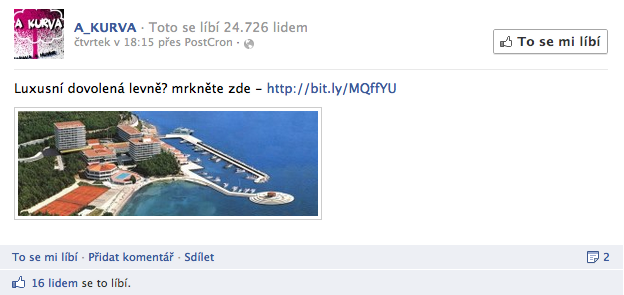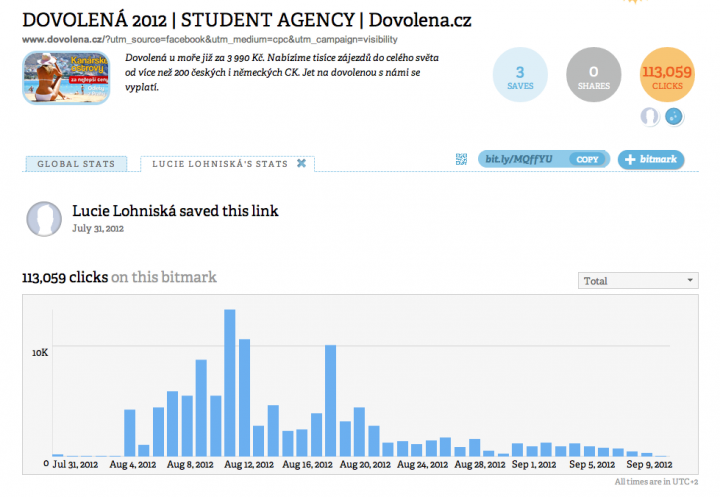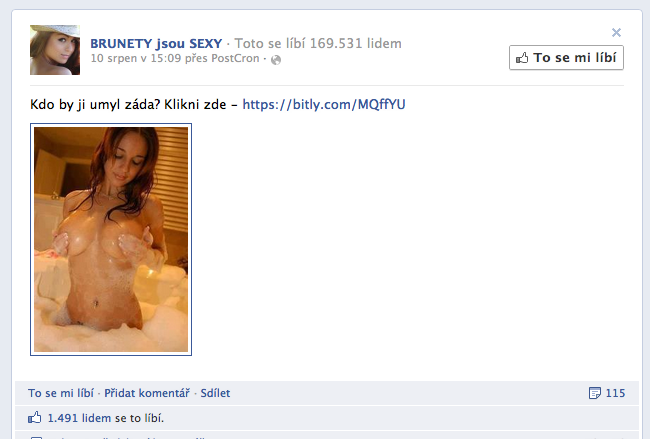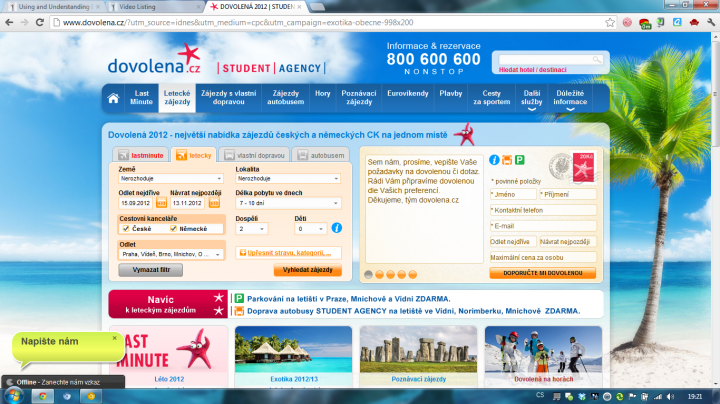The following article has been written by two of my ex-colleagues from Ataxo Interactive – Josef Šlerka (managing director) and Eliška Hutníková (social data analyst) for their new project Databoutique.cz where they will hopefully share more of amazing findings they discovered when working on Ataxo Social Insider (a social media monitoring tool – disclaimer: I used to work on this project too). They shed some light on the gray area of monetizing Facebook traffic. I believe this is a case study you won’t find on Facebook Studio, but it might be of interest for many businesses. The original article has been re-published on a leading IT website Lupa.cz with some questions to Eva Sedlmajerová, business director of Dovolena.cz. She stated the campaign was prepared by an external agency and is seen as a success, however, she didn’t disclose any data about its profitability. I asked her some additional questions and you can find her answers at the end of the article.

If you love it, Like it! (photo by badjonni)
When debugging some new features for clustering similar contributions in social networks in our Social Insider, we found some interesting results for the keyword “vacation”. Look at the screenshot:
All the references were from more than thirty pages on Facebook; each reference varied the text with the keyword “vacation” in a different way and contained a link to the same page. It was no surprise that the page contained a vacation offer, in this case an offer from Student Agency. (Disclaimer: We don’t care that it was this company, we don’t judge the practice described below, we’re only interested in it for the purpose of study. The data obtained in this research were gathered last week through open sources). As one might expect from the called URL (http://www.dovolena.cz/?utm_source=facebook&utm_medium=cpc&utm_campaign=visibility – and the HTML page source code), the company measured its unconventional campaign in Google Analytics.
How many people clicked?
When inserting links on Facebook, administrators use the popular shortener Bit.ly. An important fact was that the posting was made using PostCron for automated publishing, which uses Bit.ly as its basic shortener. We decided to use the public, though little-known, function of this globally popular shortener. If you add “+” after the original URL, http://bitly.com/MQffYU, you get access to the statistics for the shortened link: http://bitly.com/MQffYU+. And a surprise awaited us there; see for yourself:
We dare say that over 100,000 clicks for two months and a bit is a pretty good number.
On the other hand, we wondered why there were so many clicks for a total transparent advertising message. We tried to find out if there were more “advertising” posts with bit.ly URLs. There were.
Where did they come from?
In the end, we’ve found more than 1,900 advertising posts (you can download all the source data we found; we published them in Google Fusion Tables for other explorers).
A glance at the data shows a variety of interesting things. The campaign to increase the www.dovolena.cz homepage traffic used at least 51 pages, such as
152x Mrdáme bez gumy…!!! (Fucking without rubber)
142x Česky a Slovenky jsou nejhezčí holky na světě  (Czech and Slovak girls are the most beautiful girls in the world)
(Czech and Slovak girls are the most beautiful girls in the world)
138x ŠOK odhalení podvodu Stevia z Česko-Slovensko má talent (Shocking: Stevio’s fraud in Czecho-Slovakia Got Talent)
136x A_KURVA (Damn)
104x BRUNETY jsou SEXY (Brunettes are sexy)
The whole list can be found here: http://goo.gl/tXhC7
At first glance, it is quite clear that these are primarily sites that they don’t offer vacations but all sorts of jokes and tripe where you can mix advertisements. A similar strategy is used for other sites (and more openly, e.g. for discount sites, but we’ll write more about this topic later on).
To give you even a better idea – these sites don’t feature campaign slogans such as “Luxurious Vacation, Click Here” but photos of nearly naked women and slogans like “Who would wash her back? Click here”. You’ll get the picture when you look at the next screenshot.
Again, you can download all the references from Google Fusion Tables here: http://goo.gl/hIBBb
“The most successful” statuses
The campaign authors used 142 different posts on at least 50 different sites. In total, they gathered an absolutely incredible number of 160,788 likes (“Like” for individual statuses). Over 500 likes were gathered for 69 posts published at four sites: “Brunettes Are Sexy”, “Fucking without Rubber …!!!”, “Czech and Slovak girls are the most beautiful in the world :-)” and “Relationship is not just about sex, JOIN us if you think so”. In this context, the more than 100,000 clicks seems like the real thing.
Of course, one could ask if the likes were from an extensive network of fake profiles. Frankly, we don’t know how to safely machine-recognize false accounts using only the data from the Facebook API. In this case it would be legitimate to expect mainly Czech fans, and men. That’s why we used the API to download up to 100 users per post and choose a set of those who had least 25 likes. It seems that if they were bots they were well chosen – almost all of them are men and two-thirds are Czechs or Slovaks. You can examine the data yourself: http://goo.gl/hOiuy
What else you can learn from the link
Are you interested in the UTM parameter in the link? So were we. On dovolena.cz, it seems the visits from these links are classified as CPCs (i.e. Cost Per Click) like the visits from banners on iDnes.cz (top 3 Czech news server):
or AdWords ads:
Therefore, the turnout brought in this way was probably paid by dovolena.cz “per piece”. In its own channels the company uses a more predictable classification “social” (when using tags). On its Facebook page, it doesn’t use tags – although inconsistently. On Google Plus, the source is tagged as “facebook” and the campaign as “discussion”.
Can it make money?
A solid number of 100,000 clicks in a few weeks is definitely not a bad number, even though you might be sceptical about the commercial success of such a “campaign” (i.e. the percentage of site fans who actually bought something). The whole game but could be pushed even further.
Have you seen the same advert repeatedly for a company whose website you’ve visited recently, all over the Internet? It’s probable that during your browsing you reached a page that tagged you with the so-called re-marketing code. Now, you will see the company’s banners on any website in the Google content network.
Ultimately, this entire structure could be monetized in a better way. If you tag the users in your site network with a specific re-marketing code, you can show them more relevant ads – in this case, luring them with beautiful girls in a pool and litres of cheap alcohol. This is quite easy to imagine and really effective. The dovolena.cz site doesn’t do that, at least not now (you can check the source code of the cookies sent to your browser from the page).
It’s more than likely that Student Agency purchased the traffic to their site from an agency or a freelancer. According to the offer I’ve had the opportunity to look at, the price per click could vary from 40 halers to several Czech crowns (= from two euro cents to tens of euro cents). However, it would still be far below the price that the firm would pay for a traditional or Facebook campaign. That’s exactly the reason why Facebook bans and penalizes such campaigns.
Josef Šlerka, Eliška Hutníková
Adam Zbiejczuk: Dear Mrs. Sedlmajerová, in your response to the questions asked by Lupa.cz you said the campaign had been created by an external agency. Can you reveal the name of the agency? Do you cooperate with other social media agencies?
Eva Sedlmajerová: Yes, we cooperate with other agencies on social networks, either in consulting or implementation. For the communication about the agencies you can speak to Mr. Josef Kovář from eTarget.cz.
AZ: Are you satisfied with the results of the FB Page dovolena.cz itself? Although it has more than 24,000 fans, the “People talking about” metrics shows really low numbers and the last post is from 25th September (written on 8th Oct, another post has been posted on 12th Oct and then again nothing). Do you set any targets for the Page?
ES: We’re not satisfied with our Facebook Page and its activity. We know about this problem and we are currently working on a concept that we should launch in November and which should significantly increase the social network’s potential. This concept is not only for Facebook, but also for other social networks.
AZ: You have mentioned the upcoming case study, can you specify if and when the professional public will be able to read it?
ES: So far we have no exact date, but we’d like to have it published by the end of this year.
AZ: In your comments to the questions asked by Lupa.cz you downplay the significance of usage of pages like “Mrdáme bez gumy” (means literally “Fucking without rubbers) – but you didn’t answer the question about using the links like “Her naked photos only for 18+ here” that led people to your site. Don’t you think it is a clear case of false advertising? And as the people in the discussion under the original article pointed out, you are responsible even if the campaign was created by someone else. Can you comment on it?
ES: Unfortunately, there was a mistake. We’re not downplaying this fact, but emphasizing the narrow-minded effort to tabloidize the whole case. Instead of contemplating the results of the whole campaign, experts like Mr. Šlerka deal only with a minor part of it, which is a shame for the professional public. Of course, we understand their intention, but we don’t wish to comment on it further.
According to the definition under §45 of the Commercial Code, misleading advertising is spreading information about your own or another company, its products or performance, which can create a false impression and bring your or another company an advantage in competition or in economic transactions at the expense of other competitors, consumers or other clients. We haven’t shared this opinion with other discussers.
AZ: If you have any other comments that you would like to share with an international audience, I’d be happy to publish them.
ES: Trying out new marketing ideas in the Czech market is very difficult, especially when facing leading agencies who just copy foreign formats and criticize new concepts, and when tabloidization replaces a constructive discussion. But we were ready for this situation, and we’d be happy to show other businesses that common standards for advertising business are a necessity today, but an extra step has to be made to make progress.












